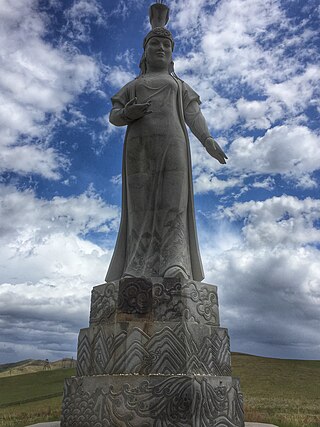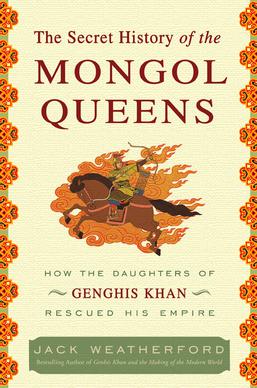Börte Üjin, better known as Börte, was the first wife of Temüjin, who became Genghis Khan, the founder of the Mongol Empire. Börte became the head of the first Court of Genghis Khan, and Grand Empress of his Empire. She was betrothed to Genghis at a young age, married at seventeen, and then kidnapped by a rival tribe. Her husband's rescue of her is considered one of the key events that started him on his path to becoming a conqueror. She gave birth to four sons and five daughters, who, along with their own descendants, were the primary bloodline in the expansion of the Mongol Empire.

Ögedei Khan was the second ruler of the Mongol Empire. The third son of Genghis Khan, he continued the expansion of the empire that his father had begun.

Jochi, also spelled Jüchi, was a prince of the early Mongol Empire. His life was marked by controversy over the circumstances of his birth and culminated in his estrangement from his family. He was nevertheless a prominent military commander and the progenitor of the family who ruled over the khanate of the Golden Horde.

Hö'elün was a noblewoman of the Mongol Empire and the mother of Temüjin, better known as Genghis Khan. She played a major role in his rise to power, as described in the Secret History of the Mongols.

Sorghaghtani Beki or Bekhi, also written Sorkaktani, Sorkhokhtani, Sorkhogtani, Siyurkuktiti, posthumous name Empress Xianyi Zhuangsheng, was a Keraite princess and daughter-in-law of Genghis Khan. Married to Tolui, Genghis' youngest son, Sorghaghtani became one of the most powerful and competent people in the Mongol Empire. She made policy decisions at a pivotal moment that led to the transition of the Mongol Empire towards a more cosmopolitan and sophisticated style of administration. She raised her sons to be leaders and maneuvered the family politics so that all four of her sons, Möngke Khan, Hulagu Khan, Ariq Böke, and Kublai Khan, went on to inherit the legacy of their grandfather.
Khulan was an empress consort of Genghis Khan and head of the second Court of Genghis Khan. Her status in the Mongol Empire was second only to Grand Empress Börte.
Oghul Qaimish was the wife of Güyük Khan, the third ruler of the Mongol Empire, and was herself the nominal regent of the empire between Güyük's death in 1248 and the accession of Möngke Khan in 1251.
Temülün was the youngest full sibling and only sister of Genghis Khan, the famed founder and Great Khan of the Mongol Empire. Her parents were Yesügei, chief of the Borjigin clan in the Khamag Mongol confederation, and his second wife Hö'elün. She was nine years younger than Temüjin.

Genghis Khan, also known as Chinggis Khan, was the founder and first khan of the Mongol Empire. After spending most of his life uniting the Mongol tribes, he launched a series of military campaigns, conquering large parts of China and Central Asia.
Mongol campaigns in Central Asia occurred after the unification of the Mongol and Turkic tribes on the Mongolian plateau in 1206. Smaller military operations of the Mongol Empire in Central Asia included the destruction of surviving Merkit and Naimans and the conquest of Qara Khitai. These were followed by a major campaign against Khwarazm. Expansion into Central Asia began in 1209 as Genghis Khan sent an expedition to pursue rivals who had fled to the region and threatened his new empire. The Uyghur kingdom Qocho and leaders of the Karluks submitted voluntarily to the Mongol Empire and married into the imperial family. By 1218 the Mongols controlled all of Xinjiang and by 1221 all the territories of the former Khwarazmian Empire. In 1236, the Mongols defeated the eastern portions of Cumania and swept into Eastern Europe.

The Secret History of the Mongol Queens: How the Daughters of Genghis Khan Rescued His Empire is a 2010 book by Jack Weatherford, about the impact and legacy of Genghis Khan's daughters and Mongol queens such as Mandukhai the Wise and Khutulun. The book references Mongolian, Central Asian, Persian, European and Chinese sources such as Altan Tobchi, Erdeni Tobchi, Erdenyin Tunamal Sudar, Tarikh-i-Rashidi, Tarikh-i Jahangushay-i Juvaini, and Ming shi in addition to various secondary sources in English, Mongolian, and German.
Yesugei Baghatur or Yesükhei was a major chief of the Khamag Mongol confederation and the father of Temüjin, who later became known as Genghis Khan. Yesügei was from the Borjigin family, and his name means "like nine", meaning he had the auspicious qualities of the number nine, a lucky number to the Mongols.
Al-Altan, also known as Altalun and Altaluqan, was the youngest child and favourite daughter of Genghis Khan, the founder of the Mongol Empire, and Börte, his primary wife. As part of Genghis's policy of marrying his daughters to powerful rulers in exchange for their submission to him, she married Barchuk, the ruler of the wealthy Uighur people to the southwest, in around 1211.
Checheyigen was the second daughter of Genghis Khan, the founder of the Mongol Empire, and his first wife Börte. As part of Genghis's policy of marrying his daughters to powerful rulers in exchange for their submission, she married a prince of the Oirat tribe, who lived near Lake Baikal, in 1207. There, she assumed a high-ranking administrative role among her husband's people, organising people and flocks like other high-ranking nomadic women. Over the following decades, Checheyigen arranged a series of advantageous marriages for her seven children and, after she backed the successful side in the Toluid Revolution of the early 1250s, her Oirat family became one of the most powerful in the empire. However, her descendants failed to take full advantage of their position, and eventually lost most of their influence.
Alakhai Bekhi was the third daughter of Genghis Khan and his first wife Börte. She acted as Regent of the territories in China proper conquered by her father after he withdrew to the Mongolian Plateau in 1215.
Fatima was an influential figure in the Mongol Empire as a favourite of Töregene Khatun, regent of the empire from 1241 to 1246.
Möge Khatun, was a princess of the Bakrin tribe and concubine of Genghis Khan. After the Khan’s death, Möge became a wife of Genghis' son, Ögedei Khan. She was briefly regent in 1241.
Ibaqa Beki was a Kerait princess and Mongol khatun active in the early 13th century. She was briefly married to Genghis Khan, the founder of the Mongol Empire, and subsequently married to the general Jürchedei.
Sochigel was either a junior wife or concubine of Yesügei, the chief of the Khamag Mongol confederation and father of Genghis Khan. Sochigel's children were Ghengis Khan's half-siblings, and included Behter and Belgutei; the latter became one of Genghis Khan's advisors.
Genghis Khan had many wives and concubines. Wives and concubines were frequently acquired from conquered territory, and, in the case of Genghis Khan, sometimes whole empires, and the women enrolled as either his wives or concubines were often princesses or queens that were either taken captive or gifted to him.